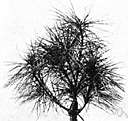However the commercial growth of the plant was forbidden in the 1920s when it was discovered that
White Pine Blister Rust was hosted by the plant and transferred to the pine trees thereby threatening the North American timber industry.
White pine blister rust (Cronartium ribicola), a Siberian fungus, landed in the port of Vancouver in 1910, and a decade later it was thriving in the pine forests of northern Idaho.
The other scourge has been
white pine blister rust, a fungus from Asia that was introduced to North America in the early 20th century.
The center works almost entirely on the pathogens Cronartium ribicola and Phytophthora lateralis, more commonly known as the cause of
white pine blister rust and of Port-Orford-cedar root disease, respectively.
White pine blister rust comes from a combination of white pines and flowering plants -- called ribes -- like gooseberries and currants.
There are likely multiple interacting causes for lack of pine recruitment, including high levels of browsing damage (Rooney and Waller, 2003; Zenner and Peck, 2009), control of fire and changes in precipitation (and resulting ecosystem "mesophication"; Nowacki and Abrams, 2008), and diseases such as
white pine blister rust (Cronartium ribicola, which can be especially damaging in moist conditions in close proximity to the Great Lakes; Van Arsdel et al., 1961).
"
White pine blister rust, a lethal disease accidentally brought to the continent on imported seedlings, has wiped out roughly 50 percent of the whitebark pine in the Rocky Mountains since its arrival in the early 20th century," reports NRDC.
Unfortunately, along with the seedlings came "hitchhikers," like
white pine blister rust, which caused up to 80% mortality in mature white pine groves in the early twentieth century.
Treatments to limit
white pine blister rust have included the physical removal of understory species in the genus Ribes, which is an alternate host for the pathogen (Maloy 1997); chemical spraying of Ribes species; and breeding of resistant sugar pine (Samman and Kitzmiller 1996).
Both pines are dying from a combination of an introduced disease (
white pine blister rust), mountain pine beetle, fire suppression and a warmer climate.
For almost 100 years, the United States waged a war against currants and gooseberries because they serve as an alternate host for
white pine blister rust, a devastating disease of northern forests.
This dark, sweet, dessert gooseberry is highly resistant to both
white pine blister rust and powdery mildew, the fruit's biggest disease threat.
 white pine blister rust - any of several diseases of pines caused by rust fungi of the genus Cronartium and marked by destructive invasion of bark and sapwood and producing blisters externally
white pine blister rust - any of several diseases of pines caused by rust fungi of the genus Cronartium and marked by destructive invasion of bark and sapwood and producing blisters externally